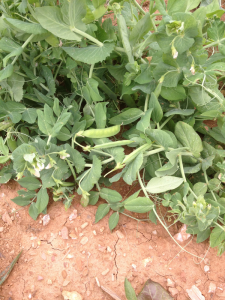
English Pea Plant
English Peas are one of those vegetables that says late spring to me. They have a very short growing season where I live, so its one of those vegetables that you really need to pounce on when they are available.
While English Peas aren’t the lowest carbohydrate vegetable around, a little in a recipe can go a long way. I’m not really eating them fresh right now but I do want to have some in both my freezer and pantry for winter recipes.
To be clear, these legumes are packed with nutrition. A cup of peas will contain about 117 calories, 7.86 grams of protein, and 13.55 grams of net carbohydrates. They are excellent sources of folic acid and vitamin C. Peas are high in Vitamin K, so should be avoided by those on warfarin. They are also rich in calcium, iron, zinc, copper and manganese.
Peas are expensive in stores mainly because they are labor intensive. A pound of peas in the shell comes out to about a cup of shelled peas. If you are okay giving up some time to pick them, then it really is cost-effective to do so.
I have a pick-your-own farm nearby that grows English Peas. Last weekend I went out there and began to collect the peas. Unfortunately for me, it was at the beginning of the growing season so while there were lots of peas on the bushes, very few of them were actually ripe.
A ripe pea will have a rounded, plump pod. You will be able to feel the actual peas in the pod and they should be firm and fill the pod to bursting. Unripe peas will have pods that are flat or slightly rounded. You won’t be able to really feel the peas.
So I went searching for ripe peas. I spent two hours stooped over, looking for ripe peas. At the end of the two hours I had to quit. My back and legs were aching and the humidity was rising, a storm was coming in. I ended up picking about 6 pounds of peas.
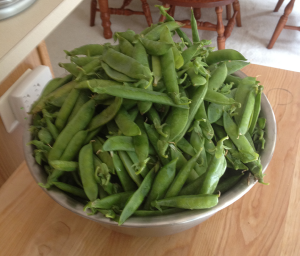
6 pounds of peas ready to be processed
The faster your food can be processed and stored, the better. Longer waiting times equals a loss of both flavor and nutrition. So once I got home, I rinsed the pods and began to shell. About 1/3 of the way through shelling the peas, my area was placed under tornado warnings. So rather than leave the peas I took them into the basement with me and continued shelling them. When I finished I had just under 2 pounds of shelled peas (6 cups).
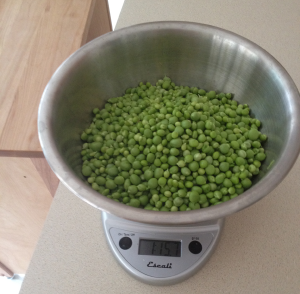
Just under 2 pounds of shelled peas
Since I wasn’t planning on eating the peas fresh this year, I needed to process them for storage. Peas will freeze well, but need to be blanched before freezing. Unfortunately, I was still under a tornado warning, with 6 cups of peas that needed to have something done with them and there was no way I was going to be in my kitchen, boiling water and blanching peas. So I took an easier way out. I dehydrated the peas.
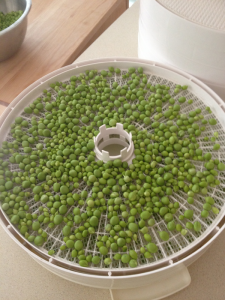
All the Peas went into the dehydrator
I got my dehydrator out, and used the screens I have to go on top of each tray since the peas would fall through the trays otherwise. I then placed about 1 cup of peas per tray and dehydrated overnight.
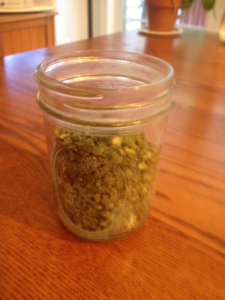
The Final Product, just under a pint of dehydrated peas.
Dehydrated peas are also called split peas (since in industrial food preparation, there is a skin which keeps both pieces of the pea together, that dries and rubbed off ). They can be used to make soup, or be an ingredient in soups and stews and other slow cooking dishes. They also keep well, a few years vs 1 year for frozen.
I also wanted to freeze some peas so I went out again this past weekend to pick some more. Luckily the peas were much more prolific and I was able to pick about 3 1/2 pounds of peas in around 30 minutes. (Much better).
One of my first books on food processing was The Busy Person’s Guide to Preserving Food: Easy Step-by-Step Instructions for Freezing, Drying, and Canning. It’s still one of my go to books. In it I learned about using my food compactor to bag vegetables and then blanch them in the bag. It really works and is so much easier than trying to blanch food directly in water.
Peas need to be blanched before freezing. This slows the enzymatic ripening (and rotting) process actions which can cause a loss of flavor and texture. Frozen peas will keep for about a year before starting to lose their nutritional value. When I do freeze my peas. I use my food compactor to bag and vacuum seal the peas first, then hold the sealed bags in boiling water for 4 minutes. I then immediately plunge the bags in ice water to halt the process and then dry the bags and toss them into my freezer.
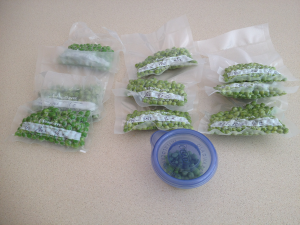
Peas waiting to be blanched and frozen
Each bag contains 1/2 cup. I ended up with 4 1/2 cups of frozen and about 1/4 cup of fresh peas which went into my sautéed greens for dinner.
Frozen peas work really well for just defrosting and cooking them in some water and butter. It’s nice to have these tasty vegetables far beyond their short growing season.
Related articles






